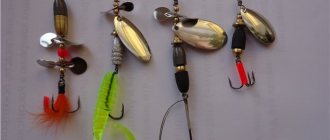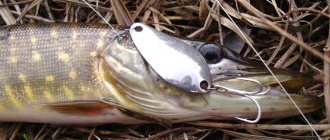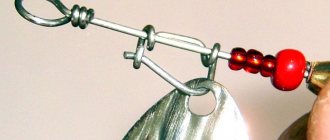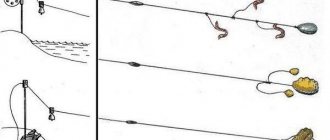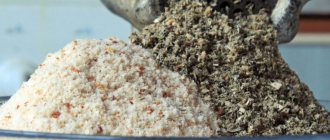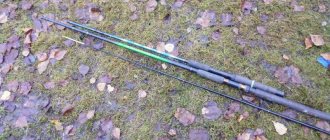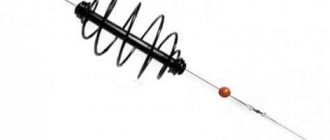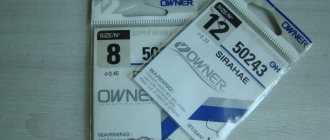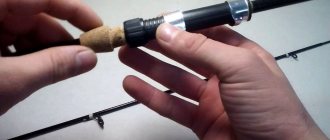Yuri 07.10.2020 388
In fact, now there is simply a colossal number of ways to catch a predator. One of the best fishing options is pike fishing. In some situations, it can bring much more catch than other equipment. I will tell you in as much detail as possible about the design of this gear, as well as how to use it correctly.
Advantages of donkey when fishing for pike
When catching any fish, the choice of gear depends on the characteristics of its behavior, food preferences and activity, and this also applies to pike. Pike are caught with a spinning rod from the surface and in the water column, but also in the bottom layer, especially during periods of gluttony, it looks for food, and in this case it is the bottom that helps to interest the fish with a tempting bait.
The toothy predator is capable of waiting for a long time and looking out for its next victim, including those that prefer to hide in holes or stand near undercuts. Unlike active spinning, the use of bottom gear refers to passive fishing, but there are situations when it is more effective in both short and long sessions.
The advantages of catching pike on a donk are that:
- with the help of this gear, if necessary, long casts are made;
- effective fishing in the current, at great depths;
- you don’t need to monitor the tackle all the time; when a fish bites, the alarm goes off and all you have to do is hook the fish and bring it to the shore;
- the bait is in the same place and waits for the voracious pike.
Unlike spinning fishing, the use of a donkey allows you to fish the far reaches of a reservoir, regardless of whether it has a current or a lake with standing water.
Properly tied equipment flies far and it is easier for the fisherman to throw it to the designated fishing point. This, of course, is not a carp rod with a filigree, precisely selected rig that flies at a distance of 100 meters and further, but the pike rod also has good flight characteristics.
If you have a watercraft, boat or raft, then pike fishing is simplified, but the casting tackle is quite long-range, and its use does not require constant movement around the reservoir with oars or a motor.
When fishing on rivers with strong currents and at great depths, bottom rigs for pike are more effective than spinning rods. Thanks to the use of a heavy sinker, the bait on the hook is delivered to a given point, regardless of how deep it is. When the depth at the fishing point is 2–3 meters, spinning baits show their best sides.
But if the depth is greater, and there is also a strong current, the donka catches the spinning rod and has clear advantages. In such cases, the correct selection of the sinker, or rather its weight, is very important, because you need the bait to be at a given point and not be washed away by the flow of water. On the other hand, a sinker that is too heavy makes fishing difficult and alarms large pike, so you have to look for a “golden mean.”
To cast a load that is too heavy, you will need a powerful rod, and the tackle becomes coarser, which will affect the fishing results.
Important! Select a sinker such that it holds the bait at a given point, but when a predator bites, it does not create obstacles for fishing. The tackle must be sensitive and this depends on the correctly selected load.
Another advantage of the rod for pike is that it does not require constant attention from the angler and you only need to pick up the rod when the alarm indicates a bite.
After casting the bottom tackle to the pike, the rod is installed on the stands, and the fishing line is fixed with a signaling device and all that remains is to wait for the bite. Due to the fact that the rod does not require constant attention, anglers place 3-4 donks, thus increasing the chances of a qualifying catch.
Pike don’t bite on the bottom every five minutes, and sometimes you have to wait at least an hour for a bite, so there’s enough time to service all 4-5 rods. When fishing with 5 donks, it is possible to fish several promising areas and look for fish, expanding the fishing sector, which gives an advantage over spinning anglers using only one rod.
Changing bait or bait on the bottom takes 5–7 minutes, so the fisherman never gets bored. On the other hand, when fishing with a spinning rod, the angler needs to constantly recast the tackle, and also work with the reel, reeling in the fishing line or cord. Not everyone can do this tedious task, but using bottom gear when fishing for pike does not require constant physical effort.
It is easier for older fishermen to catch pike on donkeys, and they take advantage of this equipment, both on rivers and at stakes. Even if there is a sudden bite from a predator, thanks to the correctly configured friction brake of the reel, the angler always has time to react and hook the fish.
Another advantage of the donkey for pike is that after casting the tackle is in a calm state, and there are no factors that deter large trophies. Before attacking the bait, the pike carefully observes its behavior and if something alerts the predator, it will choose another target.

But in the installation of the donkey there are no elements that can frighten or alert the predator, and the bait is in a natural position, so the likelihood of biting and catching fish increases significantly.
Features of the tackle
Zakidushka is the simplest version of donka. Such tackle consists of a piece of fishing line leashes with hooks and sinkers attached to it .
It also includes a reel on which all the equipment is wound.
The zakidushka has significant advantages:
- it does not require the constant participation of the angler in the process of hunting for pike;
- materials for its manufacture are inexpensive;
- This donkey is easy to use.
Each angler can make several hooks or even several dozen such gear and use them at the same time . In this case, it covers a larger area of water, and the chances of a good catch increase .
Donka has an advantage over other gear when fishing takes place at great depths and in strong current conditions. They are well suited for fishing in cold water - early spring, late autumn and winter. It is during these periods that pike prefers to stay at depth , where it is not always possible to reach it with a float rod and is often inconvenient to catch with a spinning rod.
that is passive in cold water is well fish lying motionless on the bottom or live bait tied to one point by a sinker lying on the bottom.
But this gear also has disadvantages :
- due to the lack of a fishing rod, it is not easy to cope with a good-sized trophy;
- in most cases, the zakidushka is inferior to other amateur gear in terms of effectiveness;
- Fishing with such a bottom is inferior in its sportiness to fishing with a spinning rod or a float rod.
When fishing with bait, you can use live bait as bait , as well as whole or cut dead fish. Live bait turns out to be more attractive to a predator, but it can bury itself in the bottom, becoming inaccessible to a potential trophy. In addition, live fishing is a relatively complex activity that presents more difficulties.
Flaws
But, despite the fact that pike donks have undoubted advantages, they, like any other tackle, have drawbacks. These shortcomings are offset by the catchability of bottom gear, but they need to be mentioned so that fishermen consciously choose equipment for catching predators.
So, the disadvantages of donkey for pike:
- The mobility of the tackle is low and both the float rod and the spinning rod clearly outperform the donkey in this regard.
- When fishing with a live bait bottom, the freedom of movement of the bait is limited by the length of the leash, but the float tackle gives more freedom and the live bait behaves more naturally, attracting pike.
- When reeling out the gear, snags occur on bottom obstacles, snags, stones and flooded trees. The hooks become dull or simply come off, forcing the fisherman to waste time retying the rigs.
When fishing for pike with a spinning rod, the angler moves along the shore of the reservoir in a given direction and fishes large areas. If a fish is found, then the tackle is cast to one point until the bites end.
After the bite subsides, the fisherman moves further along the shore and there is no need to move rod racks with alarms, chairs on which the fishermen sit and a bunch of other belongings necessary for fishing. Spinning fishermen are mobile and travel several kilometers a day in search of fish. Bottom fishing limits the mobility of the fisherman and this is of course a big disadvantage.
Therefore, you should carefully select the place on the shore for fishing and the points at which the sharp-toothed predator will be caught. Those who have several rods fish large areas of the reservoir, but when using 1-2 rods this is not possible. In the absence of a bite, it is much more difficult for bottom fishers to move to another point in search of fish and this is a serious drawback of bottom gear.
When catching crucian carp or crucian carp on a bottom, the fish are attracted to the fishing point with the help of a starting feed and retained by regularly throwing bait into the swim. This will not work with pike, since it does not respond to standard baits and the best bait for a predator is considered to be live bait, a small fish that has a seductive appearance and a smell that spreads over a large area.
Live bait on the bottom is a wounded fish that seeks to hide behind some kind of shelter at the bottom of the reservoir and the vibrations of its fins and tail are also caught by the predator. Pike will not pass by such bait and will definitely be tempted to bite.
But if there is no predator fishing in the area where fishing is taking place, it is very difficult for an angler with 4-5 donkeys to move to another point and try his luck in a new place. It turns out that waiting for many hours does not bring results and the fisherman is left without trophies.
Hooks for pike fishing must remain sharp, otherwise the hook will be unreliable and the fish will fall off the hook when fishing. Pike is one of those opponents that actively resist and try in every possible way to get rid of the hook.
Therefore, the fisherman must be confident in the reliability and catchability of his gear and hooks, this concerns first of all. And when reeling out the equipment to check the bait, or playing for fish, the hooks become dull on stones and bottom debris, and you have to re-tie the rigs.
Pike is caught using several types of donks, but the live bait version is considered the most catchy. However, the movement of live bait in the water column is limited by the length of the leash and this also narrows the angler’s capabilities, and therefore reduces his catch. But a living fish at least moves in the water, but fishing is also carried out on dead fry, and in this case the attractiveness of the bait is significantly reduced.
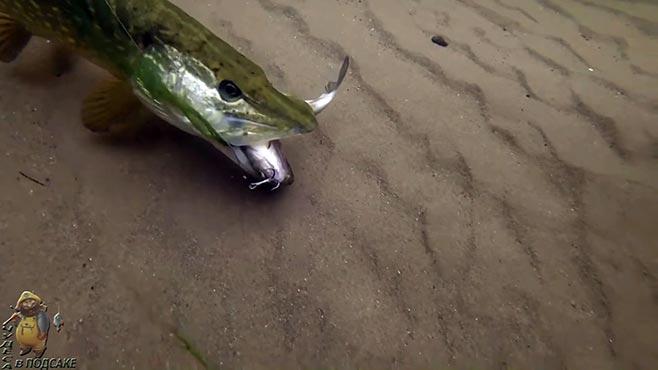
Basic techniques and fishing techniques
- A place is selected on the shore that is most suitable for this method of fishing. A smooth sandy or clayey shore, free of any vegetation and irregularities to avoid hooking.
- A pole (peg) 60-70 cm high is installed on the ground, on which the reel is fixed in the lower part. The continuation of the fishing line is fixed at the top of the peg.
- For casting, a flat bank is selected.
At a distance of a step from it, the fishing line is unwound from the reel to the first leash and laid in neat rings on top of each other. This is in order to reduce the useful distance to the sinker. - A section of fishing line with leashes stretches along the border of the coastal strip. The sinker is attached to the fishing line using the throwing method. To do this, the loop is inserted into the hole of the sinker, which is threaded into the loop, followed by tightening.
- A piece of fishing line or twine with a knot at the end is tied to the sinker for easy casting.
- The bait is placed on the hooks, and the tackle is considered ready for use.
- The string (cord) is taken by hand and after some swinging in the lower position to aim for an accurate cast, with a sharp swing the sinker is sent into flight with the subsequent contents at an angle of 45º to the horizon.
- After installing the sinker in a stationary position, the slack is removed from the bottom of the fishing line and fixed at the top of the shaft. Excess fishing line is wound on the reel.
- To signal a bite, you can attach a bell with a previously made figure-of-eight loop at a distance of 0.5 m from the peg.
For lovers of silence, in order to avoid the ringing of bells and not attract curious onlookers with the standard annoying questions “what..., how..., what..., but here I was yesterday...”, instead of a bell, you can hang a piece of a shaft with an end split or install an additional whip in front of a peg with pinching the main line in it.
Fishing process in reverse order:
- the fishing line is neatly rolled into rings at the peg;
- a section of fishing line with leads is laid along the shore;
- the fish, removed from the hook, is sent with a slight movement of the hand into a fish tank or other bag intended for it;
- the bait on the gear is replenished and, if necessary, updated;
- the process is repeated.
Please note: in hot weather, fish should not be stored in a plastic bag with water added from a pond. The shelf life is sharply reduced. It is better to fill the bag with nettles and place it in the shade in a windy place. Or, make a hole in the sand until the humidity is cool, where you can sprinkle your amazing catch.
Varieties of donks for pike
It is believed that three options for donkey are suitable for successful pike fishing:
- classic installation on a reel;
- donk with a rubber shock absorber;
- Donka spinning rod with live bait.
The first two options for donks have significant drawbacks and should not be seriously considered as catching tackle specifically for pike. When catching crucian carp or bream, and bottom fishing, elastic and classic bottom rigging are much more effective and this is due to the characteristics of the oral apparatus of these fish.
Pike has sharp teeth, with which it can gnaw even thin wire, not to mention monofilament fishing line or braid, from which leashes for classic donks and elastic bands are knitted. Therefore, it is recommended to use a donka with a spinning rod, equipped with metal leashes for pike and hooks with live fish.
This is the option that attracts both small and trophy pike, and there is plenty of evidence of this in the form of trophies caught. Tying a donkey for a pike with a spinning rod with your own hands is not at all difficult, and every angler can learn how to do it quickly and easily.
Fishing with an elastic band
On many forums, fishermen talk about the catchability of this method. Easy to implement. Not just one live bait is attached to the fishing line, but several at once, which enhances the effect (imitation of a school of small fish).
The picture shows how to properly mount this gear.
Rod
A rod for pike must be able to withstand heavy loads and have the flexibility necessary to fish for a trophy. Hooking a pike should be quick and precise, and the tip of the spinning rod, which has rigidity, is responsible for this. Some anglers use carp rods designed for catching 10+ kg trophies, but this is not necessary.
There is no need to buy expensive equipment for pike fishing; a titanium spinning rod or a budget telescopic fishing rod made of carbon fiber will do. Rod length from 2.4 to 3.0 meters, test 2.5 Lb and above. If there is a possibility of catching a trophy pike weighing 5 kg or more, the rod must withstand such a load, this must be taken into account.
How to make a snack with your own hands
If you watch the video of making a zakidushka, it will become absolutely clear that you don’t need much talent to do this job.
We invite you to read: Fishing for goby on the Black Sea: gear for catching Azov goby from the shore and boat
It is enough to choose the right material for the coil, since it will constantly come into contact with water and carpentry tools such as a hacksaw, electric drill and file will bring the coil into proper condition.
To simplify the task, you can consider the option: how to make a spinning rod. This work will be done much faster.
Coil
For catching pike on a donkey, a spinning or carp reel with a spool of 3000 and above is suitable. The larger the size of the spool, the faster the line is reeled out and when fishing at long distances, reels with spools of 4000 and above are used.
When fishing coastal areas with bottoms, they use reels with 3000 and even 2500 spools, the main thing is that they are equipped with reliable and functional friction brakes with fine tuning. When fishing for pike with a bottom, the angler does not need to hold the rod in his hands all the time, as is the case with spinning anglers, so the weight of the reel does not play a big role.
It is desirable that the reel be protected from moisture and sand getting into the middle and be equipped with 3 or more bearings.
Live bait fishing methods
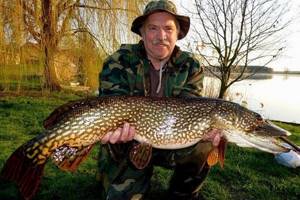
It is possible to catch pike with live bait using various fishing techniques. At the same time, each method of catching predatory fish differs from each other, although only slightly. It is especially important, despite the options for using equipment, to know the behavior of the toothy predator, then you can count on a positive fishing outcome. The choice of a promising location plays a very important role.
For catching pike with live bait, it is permissible to use the following gear:
- Mugs.
- Bottom fishing rods.
- Walking donka.
- Float live bait fishing rod.
- Summer girders.
Below in the article you can find out in more detail how these types of gear differ from each other and how to catch pike with them.
Fishing with mugs
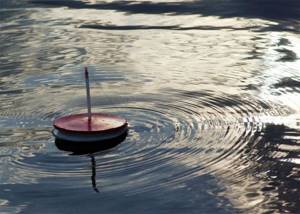
Our grandfathers and great-grandfathers also caught pike with mugs, so the fishing method is familiar to many anglers. For effective fishing, several circles are used, which are installed at different points in the reservoir. When a pike takes bait, the circle turns over, signaling a bite. When the angler swims up to the circle, the pike has already managed to swallow the bait. The fisherman can only hook and pull the predator out of the water.
The advantages of this fishing method include:
- The gear can be installed in any promising place in the reservoir, taking into account the characteristics of the bottom topography, as well as the presence of aquatic vegetation.
- The mugs are simple in design, so even an inexperienced angler can understand their structure.
- Alternatively, mugs can be purchased at specialized retail outlets or at the market.
- The mugs are highly effective despite their simple design.
As an advice! The gear is simple, so to make it it is enough to use available means in the form of plastic bottles. There is plenty of this garbage these days!
You should also pay attention to a significant drawback of this method of fishing - the presence of any watercraft. Unfortunately, not every fisherman is able to purchase a boat, although this element of fishing is the dream of any angler.
Running donka
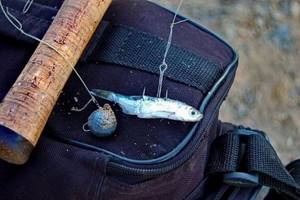
This gear allows you to catch predators from the shore when there are a lot of them in the reservoir and they are more distributed along the coastal zone. Among the advantages of this method are:
- High mobility, since the fisherman has the opportunity to move freely along the shore in search of pike.
- Using light and fairly simple gear allows the angler to feel all the excitement of fishing.
- The ability to throw bait into hard-to-reach places where there are many underwater surprises.
As a rule, the running bottom is used mainly in the summer, although this can be done in the fall, but not in the deep, while the pike has not yet gone to depth. The advantage of fishing from the shore is that you do not need to have a watercraft, which nowadays costs a lot of money.
Summer girders
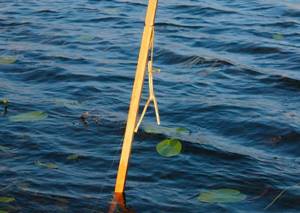
It is believed that the zherlitsa is a winter tackle for catching pike, but some fishermen, having slightly modernized and simplified it, use it for catching pike from the shore in the summer. This gear also allows you to fish coastal areas of water bodies, often quite complex ones.
It won’t be too difficult to install a summer girder with your own hands. Moreover, any angler, even the most inexperienced, can do this, and it won’t take much time. The summer girder is installed in any suitable place, and while it is standing, the angler can catch fish with a float rod, or rather, catch live bait. From time to time you can simply look at the girder in order to respond to a bite in a timely manner.
FISHING with MUGS. CATCHING FOR PREDATOR BAITS FROM A BOAT WITH CIRCLE TACKLE
Catching pike with a float rod
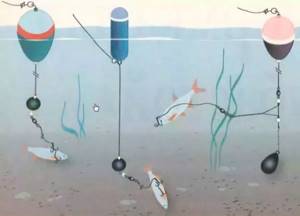
Fishing with this tackle has some similarities with fishing with a running donka, but this tackle has a float as a bite alarm. For this fishing technique, rods no shorter than 4 meters are used, and with a rod length longer than 6 meters, fishing can be problematic. If the pike is located at a considerable distance from the shore, then it is better to use a spinning rod, which allows you to cast the bait over a considerable distance. Otherwise, fishing with float tackle is no different from regular fishing. unless you have to choose a reliable fishing rod.
How to equip a float rod for pike. Pike on a float
Bottom gear
There are many variations in the manufacture of bottom gear that are used in specific conditions.
As a rule, bottom tackle is a stationary tackle, and quite simple in design. Despite its simplicity, the tackle is distinguished by excellent catchability, not only in relation to pike, but also to other species of fish. As a rule, bottom fishing rods are mainly used for catching fish such as bream, carp, chub, roach and others.
An elastic band is another type of bottom tackle, although catching pike with this tackle is quite problematic. The rubber band is installed at one promising point of the reservoir and frequent movements with it along the shore of the reservoir are simply useless: it is not easy to install and just as difficult to assemble, and this is a waste of time.
fishing line
As already mentioned, when biting a pike, the hook must be clear and accentuated, and the stretchability of the monofilament line in this case is a very negative factor. As a result, a braided cord with a diameter of 0.25 and above is used as the basis for pike donkey.
The thicker the cord, the more reliable the tackle, but when making long casts (which is what the donkey is actually intended for), the diameter of the cord should be as small as possible. Therefore, you should not use too thick cords for the base, so that the tackle does not lose all its advantages. It is recommended to use high-quality braided cords, and not Chinese fakes, which are enough for 1-2 fishing trips.
It is wrong to save on the cord, because this is an important element of equipment. In addition, cheap lines shed in water and lose their natural color, unmasking the entire tackle. By purchasing a high-quality cord, the angler is sure that he has solved the problem for at least the fishing season, although such braids are usually used to catch donka for more than one year.
Important! It is allowed to use monofilament fishing line as a base, but its diameter must be at least 0.4-0.5 mm.
What is interesting about catching fish using a hook?
Fishing with hooks, despite the simplicity of this gear, is by no means simple and varies greatly depending on where it is carried out and what kind of fish is its object.
Moreover, some types of fish require some changes in equipment. This is all worth considering in detail. As a rule, it is carried out on ponds and lakes, as well as in oxbow lakes and river branches. Main fishing objects: large roach, bream, crucian carp, carp, tench, large perch, pike perch, pike.
Fishing with hooks in still waters is often carried out where there are quite extensive thickets of underwater vegetation. In order for the equipment to catch less algae, a round or pear-shaped sinker is used.
Fishing with a hook is usually done from the shore. Moreover, a fisherman can use up to ten hooks at a time. Also, the low cost of this gear makes it very affordable for a wide range of fishermen.
In addition, many of them once asked the question: how to make a fishing hook, then not only make it themselves, but also modify it according to their taste and understanding.
Before making a fishing rod, you should once again weigh the pros and cons. These include ease of manufacture and use.
If a fisherman is wondering: how to make a cast for pike, then you should consider the following:
- compared to catfish, pike is a less powerful fish, so a fishing line with a diameter of up to 0.6 mm is suitable,
- but at the same time, the pike’s teeth are much sharper and the leash should be made better of steel with a diameter of 0.3 mm.
- By the way, the sinker can be left the same.
When catching any fish, the choice of gear depends on the characteristics of its behavior, food preferences and activity, and this also applies to pike. Pike are caught with a spinning rod from the surface and in the water column, but also in the bottom layer, especially during periods of gluttony, it looks for food, and in this case it is the bottom that helps to interest the fish with a tempting bait.
The toothy predator is capable of waiting for a long time and looking out for its next victim, including those that prefer to hide in holes or stand near undercuts. Unlike active spinning, the use of bottom gear refers to passive fishing, but there are situations when it is more effective in both short and long sessions.
The advantages of catching pike on a donk are that:
- with the help of this gear, if necessary, long casts are made;
- effective fishing in the current, at great depths;
- you don’t need to monitor the tackle all the time; when a fish bites, the alarm goes off and all you have to do is hook the fish and bring it to the shore;
- the bait is in the same place and waits for the voracious pike.
Unlike spinning fishing, the use of a donkey allows you to fish the far reaches of a reservoir, regardless of whether it has a current or a lake with standing water.
Properly tied equipment flies far and it is easier for the fisherman to throw it to the designated fishing point. This, of course, is not a carp rod with a filigree, precisely selected rig that flies at a distance of 100 meters and further, but the pike rod also has good flight characteristics.
If you have a watercraft, boat or raft, then pike fishing is simplified, but the casting tackle is quite long-range, and its use does not require constant movement around the reservoir with oars or a motor.
When fishing on rivers with strong currents and at great depths, bottom rigs for pike are more effective than spinning rods. Thanks to the use of a heavy sinker, the bait on the hook is delivered to a given point, regardless of how deep it is. When the depth at the fishing point is 2–3 meters, spinning baits show their best sides.
But if the depth is greater, and there is also a strong current, the donka catches the spinning rod and has clear advantages. In such cases, the correct selection of the sinker, or rather its weight, is very important, because you need the bait to be at a given point and not be washed away by the flow of water. On the other hand, a sinker that is too heavy makes fishing difficult and alarms large pike, so you have to look for a “golden mean.”
To cast a load that is too heavy, you will need a powerful rod, and the tackle becomes coarser, which will affect the fishing results.
Another advantage of the rod for pike is that it does not require constant attention from the angler and you only need to pick up the rod when the alarm indicates a bite.

After casting the bottom tackle to the pike, the rod is installed on the stands, and the fishing line is fixed with a signaling device and all that remains is to wait for the bite. Due to the fact that the rod does not require constant attention, anglers place 3-4 donks, thus increasing the chances of a qualifying catch.
Pike don’t bite on the bottom every five minutes, and sometimes you have to wait at least an hour for a bite, so there’s enough time to service all 4-5 rods. When fishing with 5 donks, it is possible to fish several promising areas and look for fish, expanding the fishing sector, which gives an advantage over spinning anglers using only one rod.
Changing bait or bait on the bottom takes 5–7 minutes, so the fisherman never gets bored. On the other hand, when fishing with a spinning rod, the angler needs to constantly recast the tackle, and also work with the reel, reeling in the fishing line or cord. Not everyone can do this tedious task, but using bottom gear when fishing for pike does not require constant physical effort.
We invite you to familiarize yourself with: Do-it-yourself fishing tackle boxes
It is easier for older fishermen to catch pike on donkeys, and they take advantage of this equipment, both on rivers and at stakes. Even if there is a sudden bite from a predator, thanks to the correctly configured friction brake of the reel, the angler always has time to react and hook the fish.
Another advantage of the donkey for pike is that after casting the tackle is in a calm state, and there are no factors that deter large trophies. Before attacking the bait, the pike carefully observes its behavior and if something alerts the predator, it will choose another target.
But in the installation of the donkey there are no elements that can frighten or alert the predator, and the bait is in a natural position, so the likelihood of biting and catching fish increases significantly.
It is believed that three options for donkey are suitable for successful pike fishing:
- classic installation on a reel;
- donk with a rubber shock absorber;
- Donka spinning rod with live bait.
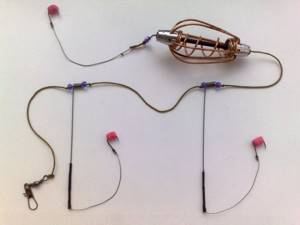
The first two options for donks have significant drawbacks and should not be seriously considered as catching tackle specifically for pike. When catching crucian carp or bream, and bottom fishing, elastic and classic bottom rigging are much more effective and this is due to the characteristics of the oral apparatus of these fish.
Pike has sharp teeth, with which it can gnaw even thin wire, not to mention monofilament fishing line or braid, from which leashes for classic donks and elastic bands are knitted. Therefore, it is recommended to use a donka with a spinning rod, equipped with metal leashes for pike and hooks with live fish.
This is the option that attracts both small and trophy pike, and there is plenty of evidence of this in the form of trophies caught. Tying a donkey for a pike with a spinning rod with your own hands is not at all difficult, and every angler can learn how to do it quickly and easily.
To install a live bait bait on a pike you will need:
- double or tee hook on a leash 30-50 cm long;
- swivel;
- bumper;
- sliding sinker;
- a piece of fishing line with a diameter of 0.4-0.5 mm, a length of 30-40 cm.
Using a sliding sinker increases the sensitivity of the tackle, and after a bite in the first seconds, the pike does not feel the weight of the load. Only after the sinker rests on the knot is the predator caught under its weight, and then the angler makes an additional hook, depriving the pike of the opportunity to get off the hook.
We mount the donk on the pike:
- Make a loop on the fishing line to connect to the base.
- Place a sliding sinker on the fishing line.
- Place a stopper on the line.
- Tie a swivel to the free end of the fishing line.
- Attach a leash with a hook to the swivel.
This version of the donkey is used in cases where it is necessary for live bait to swim almost along the bottom and in close proximity to it. The height of the fish's rise is limited by the length of the leash, but it is not a fact that the live bait will want to swim straight up.

Therefore, if the task is to catch pike in the water column, the rig is equipped with a float that raises the live bait to the required height. The bumper is needed in order to protect the connecting unit from impacts with a sinker, and the swivel, which rotates freely around its axis, prevents the tackle from getting tangled during fishing.
The design of the donkey is very simple, but this is the most catchy option. You should not complicate installations on a predator, because this will only interfere with fishing. If a fisherman experiments on a pond and tries to fish with different rigs, there are no problems, no one forbids this.
But if you want to maximize your chances of catching a trophy pike, you don’t need to invent anything, because there is gear that has been tested by time and many fishing trips.
Hooks
It is unnecessary to remind that the hook is the element of the tackle that is in direct contact with the fish and is responsible for its reliable hooking. The hook should always be very sharp and its shape should be convenient for baiting bait.
Doubles or trebles are considered ideal hooks for pike donks and they are attached to metal leashes that are “not afraid” of the sharp teeth of a ferocious predator. The rigidity of a metal leash reduces the attractiveness of the bait, as it prevents it from moving naturally.
But here you don’t have to choose, because the sharp pike teeth will cut any other material, so metal leashes, in fact, have no alternative. In the last 3–5 years, fluorocarbon predator leashes, which are rigid and resistant to abrasion, have become popular among anglers.
The undoubted advantage of fluorocarbon fishing line is its “invisibility” in water, as well as its abrasion resistance. But the strength of a metal leash is still much higher and the tackle with it is more reliable. So it is recommended to use fluorocarbon leashes when the fish are biting weakly and after hooking you need to force the predator to reel in to prevent it from biting the leash.
Choosing bait and bait
Bait and lure should be chosen based on the food preferences of the pike in the fished body of water with a reference to the time of year. In cold water, in spring and autumn, you can safely place dead fish or fish trimmings and fillet pieces cut into ten-centimeter strips 3-4 cm wide on the bait, pressing the delicacy with a weight to the bottom of the reservoir. Pike, despite the immobility of the bait, are interested in such installations due to their high feeding activity. In the summer and early autumn, pike are still more confident in taking live bait, which they place in rigs through the gill.
Important! Due to the fact that donks can remain in a working position for a long time without being checked, it is recommended to use species of live bait fish with a high degree of endurance as bait.
These types of fish include crucian carp, loach and gudgeon. Regardless of the method of baiting, this fish will live for at least a day. Roach, perch and crappies are more delicate fish, and when fishing with such live bait material, the hooks will have to be inspected at least once every 2-3 hours, to change the specimens that have fallen asleep on the hooks.
Installation of live bait for pike
To install a live bait bait on a pike you will need:
- double or tee hook on a leash 30-50 cm long;
- swivel;
- bumper;
- sliding sinker;
- a piece of fishing line with a diameter of 0.4-0.5 mm, a length of 30-40 cm.
Using a sliding sinker increases the sensitivity of the tackle, and after a bite in the first seconds, the pike does not feel the weight of the load. Only after the sinker rests on the knot is the predator caught under its weight, and then the angler makes an additional hook, depriving the pike of the opportunity to get off the hook.
We mount the donk on the pike:
- Make a loop on the fishing line to connect to the base.
- Place a sliding sinker on the fishing line.
- Place a stopper on the line.
- Tie a swivel to the free end of the fishing line.
- Attach a leash with a hook to the swivel.
This version of the donkey is used in cases where it is necessary for live bait to swim almost along the bottom and in close proximity to it. The height of the fish's rise is limited by the length of the leash, but it is not a fact that the live bait will want to swim straight up.
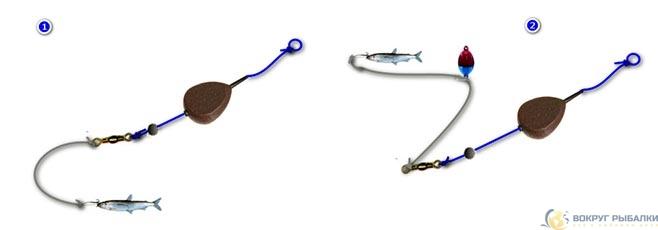
Therefore, if the task is to catch pike in the water column, the rig is equipped with a float that raises the live bait to the required height. The bumper is needed in order to protect the connecting unit from impacts with a sinker, and the swivel, which rotates freely around its axis, prevents the tackle from getting tangled during fishing.
The design of the donkey is very simple, but this is the most catchy option. You should not complicate installations on a predator, because this will only interfere with fishing. If a fisherman experiments on a pond and tries to fish with different rigs, there are no problems, no one forbids this.
But if you want to maximize your chances of catching a trophy pike, you don’t need to invent anything, because there is gear that has been tested by time and many fishing trips.
Types of tackle
There are several main types of such gear. They differ in some design features. The choice of gear type depends on the fishing conditions.
An ordinary snack
This is the simplest and cheapest option for a snack. It is a strong fishing line or nylon cord with a thickness of 0.35-0.5 mm. A weight is attached to one end of the fishing line. Lead casting can be used. For fishing in rivers, its weight is usually 10-200 grams. When fishing in still water, use a weight of up to 50 g.
Some fishermen use stones found on the shore instead of lead weights. The length of the main line usually does not exceed 50 m, because it is difficult to cast the tackle further in the usual way.
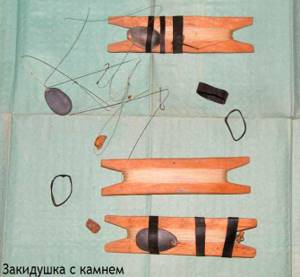
A leash is tied at a distance of 0.5 m from the sinker. It uses a thinner fishing line, its thickness is 0.2-0.3 mm. The leash is taken 0.3−0.6 m long. To ensure that the tackle takes up as little space as possible, the fishing line is wound on a plastic or wooden reel. Bells are used as signaling devices.
Read: 6 ways to make a homemade bite alarm for donkey
Zakidushka with sliding weight
Some types of fish are cautious and shy. Catching bream with a regular bait does not always bring good results. In this case, it is good to use a tackle with a sliding weight.
There are two main practical options for implementing this idea:
- a sinker in the shape of an oblong olive is attached to the main fishing line. The distance from the hook to the main line is regulated by a special rubber stopper. Instead, you can use a small piece of sheet lead. A leash with a hook is tied to the very end of the main cord. The fish takes the bait, but does not feel any resistance, since the line slides and the sinker remains on the bottom;
- A weight is attached to the main line on a leash with a swivel. The limiter is a rubber damper. Leashes with hooks are located at the end of the fishing line. In a similar way, the nozzle can be raised above the bottom. After casting, the line is pulled slightly and then fixed in this position. When biting, the fish does not feel resistance and boldly swallows the bait.
Zakidushka with rubber shock absorber
A convenient option for throwing is the so-called rubber bands. This tackle occupies a special position due to certain design features and methods of its use. Until recently, this method of fishing was considered almost poaching. So check to see if it can be used in your region.
The stretch of the elastic allows you to remove the line from the water and lower it back along with the bait. There is no need to make any casts, which makes the fishing process easier.
One of the main components of this gear is a rubber cord, which has high elasticity and the ability to stretch greatly in length.
An elastic band approximately 7-8 m long is mounted between the main line and the sinker itself. The length of the elastic is affected by the distance over which the tackle will be thrown. The speed of water flow is taken into account if it happens on a river.
Read: Fidergam

The weight of the sinker must be sufficient so that the elastic band cannot move it from its place.
The length of the main line is 25−30 m. For leashes, a line of 0.16−0.25 mm is used, the length of the leashes is 15−30 cm. Their number is from 3 to 8 pieces. Attach leashes at a distance of 15-25 cm from each other.
There is also a safety line attached to the sinker, with which you can pull out the sinker. Often a special buoy is used, attached to the load with a rope. It shows the place where the sinker is located at the bottom of the reservoir. After finishing fishing, you just need to swim up to it on a boat and pull the tackle out of the water.
How to bait live bait

Baiting with live bait is also an important point when preparing donkey for fishing. The predator attacks the bait only if it considers it safe. A protruding hook unmasks the installation, so the leash is passed through the gill openings and released into the mouth of the baitfish, after which a tee or double is attached to it.
After pulling the leash, the hook penetrates the soft tissue of the baitfish’s lips and becomes invisible to the pike. Usually the predator takes the bait by the head, and not from the tail, and after the fish enters the predator’s mouth, it is caught by the sting of the hook. The installation performs its functions perfectly, and the live bait has a “marketable appearance” for a long time.
Advantages of live bait fishing
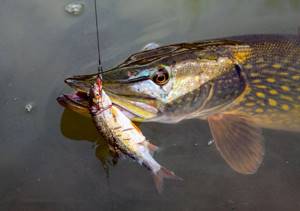
As a rule, catching predatory fish with live bait always gives a positive result, since predatory fish quite often react to natural bait. The advantages of this method of catching predatory fish include:
- The versatility of the method, since live fish can be used with any equipment, regardless of the time of year.
- It is not difficult to have bait, since live fish can be caught in the same body of water where you plan to catch pike.
- The method is cheap, since no additional costs are required for expensive artificial baits. In addition, the tackle turns out to be just as cheap.
- The use of natural bait does not require the use of additional materials and means to attract the predator.
In addition to the advantages of this fishing method, there is one significant drawback associated with storing the caught fish. In addition, the problem is aggravated if the bait has to be transported to a reservoir. This method of fishing is not considered dynamic, like spinning fishing, for example, so not all fishermen are delighted with it, especially young people.

